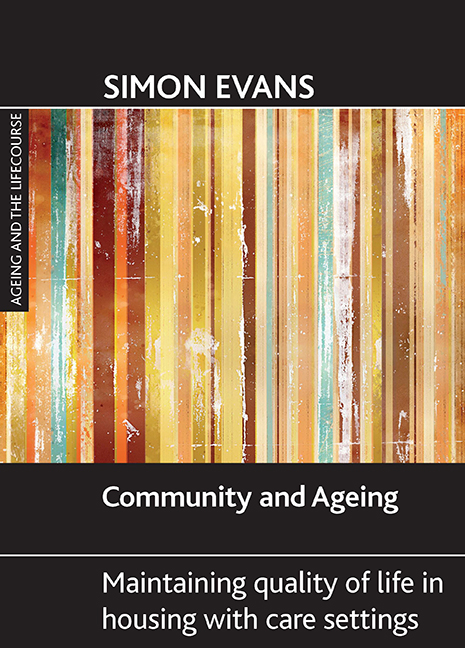Book contents
- Frontmatter
- Contents
- List of tables, boxes and photos
- Acknowledgements
- Foreword
- one Introduction
- two What is community?
- three Community and ageing
- four Housing with care communities in the UK
- five An international perspective on retirement villages
- six Promoting a sense of community in housing with care settings
- seven Diversity, community and social interaction
- eight Changing communities and older people
- nine Conclusion
- Appendix
- References
- Index
- Frontmatter
- Contents
- List of tables, boxes and photos
- Acknowledgements
- Foreword
- one Introduction
- two What is community?
- three Community and ageing
- four Housing with care communities in the UK
- five An international perspective on retirement villages
- six Promoting a sense of community in housing with care settings
- seven Diversity, community and social interaction
- eight Changing communities and older people
- nine Conclusion
- Appendix
- References
- Index
Summary
Introduction
Retirement housing settings are successful as neighbourhoods designed specifically for older people. They offer age-friendly design and opportunities for social interaction within clear physical boundaries, focusing on similarities and exclusivity rather than diversity and wider integration. The fact that they are specifically age limited contributes to their cohesiveness as neighbourhoods, but it also means that they are not compatible with creating diverse and mixed communities. Ultimately, whether we call them neighbourhoods or communities is immaterial to the people who live in them. All the evidence suggests that a sense of community belonging is important to older people in particular and many of those who move to extra care housing and retirement villages do so for that very reason.
Community and older people
Community is an intangible concept and therefore extremely difficult to pin down. To a large extent it means different things to different people, shaped by their life histories, experiences and aspirations. At a basic level, community can be defined as a sense of belonging to a social group or groups, based on communalities that span physical space, interests and identities. While early theories of community emphasised the role of place as the focus of social networks and kinship ties, there is agreement in much of the more recent literature that shared interests and identities have supplanted physical place as the main factors in a sense of community, largely as a result of globalisation and increased social mobility. Social networks and social interaction are widely viewed as the ‘glue’ that binds communities together, as reflected in concepts such as gemeinschaft and ‘social capital’. The literature identifies three main types of social relationship that vary in terms of physical distance and emotional intensity. These are relationships with close kin, with friends and neighbours and with voluntary and community groups. It has been suggested that having social networks that include all three types of relationship is better than having restricted networks in terms of good health and wellbeing. There has also been a move away from more nostalgic concepts of community that emphasise mutual support in idyllic rural settings towards a recognition that difference, conflict and social exclusion are equally important elements.
- Type
- Chapter
- Information
- Community and AgeingMaintaining Quality of Life in Housing with Care Settings, pp. 125 - 134Publisher: Bristol University PressPrint publication year: 2009

